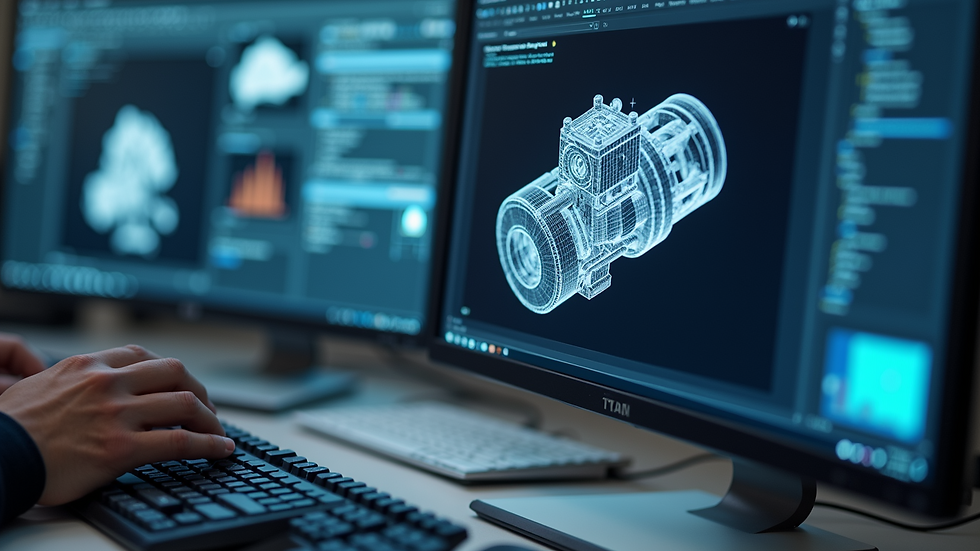How Mechanical CAD Drafting Improves Accuracy
- PV Digital

- Aug 21
- 4 min read
Mechanical drafting plays a crucial role in the engineering and manufacturing industries. It involves creating detailed technical drawings that serve as blueprints for building mechanical components and systems. The accuracy of these drawings directly impacts the quality, functionality, and safety of the final product. With the advancement of technology, mechanical drafting has evolved from traditional hand-drawn sketches to sophisticated computer-aided design (CAD) systems. This transformation has significantly improved the precision and efficiency of the drafting process.
Mechanical drafting ensures that every dimension, tolerance, and specification is clearly communicated to engineers, fabricators, and quality control teams. This clarity reduces errors, minimizes rework, and accelerates project timelines. In this article, we will explore how mechanical drafting improves accuracy, the benefits of using CAD software, and the role of professional drafting services in achieving superior results.
The Role of Mechanical Drafting in Precision Engineering
Mechanical drafting is the foundation of precision engineering. It translates complex ideas into visual representations that can be universally understood. Accurate mechanical drawings provide a detailed roadmap for manufacturing parts that fit together perfectly and function as intended.
One of the key aspects of mechanical drafting is the use of standardized symbols, notations, and dimensioning techniques. These standards ensure consistency and reduce ambiguity. For example, specifying exact tolerances on a shaft diameter helps machinists produce parts that meet strict quality requirements.
Mechanical drafting also facilitates better communication among multidisciplinary teams. Engineers, designers, and manufacturers rely on these drawings to coordinate their efforts. When drawings are precise, it minimizes misunderstandings and costly mistakes during production.

How Mechanical Drafting Software Improves Accuracy
The introduction of CAD software revolutionized mechanical drafting by automating many manual tasks and enhancing precision. CAD tools allow drafters to create highly detailed 2D and 3D models with exact measurements and geometric constraints.
Some ways CAD software improves accuracy include:
Error Reduction: CAD systems automatically check for inconsistencies and flag potential errors before finalizing drawings.
Exact Measurements: Digital tools enable precise input of dimensions, reducing human error common in hand-drawn sketches.
Easy Revisions: Changes can be made quickly without redrawing entire plans, ensuring updates are accurate and consistent.
3D Visualization: Designers can view components in three dimensions to detect clashes or misalignments early in the design phase.
Standardization: CAD libraries include standardized parts and symbols, promoting uniformity across projects.
By leveraging these capabilities, engineers can produce more reliable and manufacturable designs. This leads to fewer defects, improved product performance, and lower production costs.

What are CAD Drafting Services?
CAD drafting services specialize in creating detailed mechanical drawings using advanced CAD software. These services are often outsourced to professional firms that have expertise in various engineering disciplines and drafting standards.
Mechanical CAD drafting services provide several advantages:
Expertise: Skilled drafters understand industry standards and best practices, ensuring high-quality outputs.
Time Savings: Outsourcing drafting tasks frees up internal resources to focus on core engineering activities.
Cost Efficiency: Reduces the need for investing in expensive CAD software and training.
Scalability: Services can handle projects of varying sizes and complexities, adapting to client needs.
Accuracy Assurance: Professional drafters use quality control processes to verify the precision of drawings.
These services are particularly valuable for companies looking to improve design accuracy without expanding their in-house drafting teams. By partnering with reliable providers, businesses can enhance their product development workflows and reduce errors.

Practical Tips to Maximize Accuracy in Mechanical Drafting
To fully benefit from mechanical drafting, consider implementing the following best practices:
Use Standardized Templates
Start with templates that comply with industry standards such as ASME or ISO. This ensures consistency in dimensioning, symbols, and annotations.
Double-Check Dimensions and Tolerances
Always verify critical measurements and tolerances before finalizing drawings. Cross-check with design requirements and manufacturing capabilities.
Leverage 3D Modeling
Utilize 3D CAD models to visualize assemblies and detect potential interference or fit issues early.
Maintain Clear Communication
Collaborate closely with engineers, fabricators, and quality teams to clarify any ambiguities in the drawings.
Regularly Update Drawings
Keep drawings current with design changes to avoid confusion during production.
Invest in Training
Ensure drafting personnel are well-trained in CAD software and drafting standards to maintain high accuracy levels.
By following these recommendations, organizations can reduce errors, improve product quality, and streamline manufacturing processes.
The Future of Mechanical Drafting and Accuracy
Mechanical drafting continues to evolve with emerging technologies such as artificial intelligence, cloud collaboration, and augmented reality. These innovations promise to further enhance accuracy and efficiency.
For instance, AI-powered drafting tools can automatically generate optimized designs based on performance criteria. Cloud-based platforms enable real-time collaboration among global teams, reducing delays and miscommunication. Augmented reality can overlay digital models onto physical prototypes for immediate inspection and validation.
Despite these advancements, the core principles of precise mechanical drafting remain essential. Combining human expertise with cutting-edge technology will drive the next generation of accurate and reliable engineering designs.
For companies seeking to improve their design accuracy, partnering with specialized mechanical cad drafting services can provide a competitive edge. These services bring together skilled professionals and advanced tools to deliver precise, high-quality mechanical drawings tailored to your project needs.
Mechanical drafting is more than just creating drawings - it is about ensuring every detail is correct to build products that perform flawlessly. By embracing modern drafting techniques and professional services, businesses can achieve greater accuracy, reduce errors, and accelerate innovation in mechanical engineering.





Comments